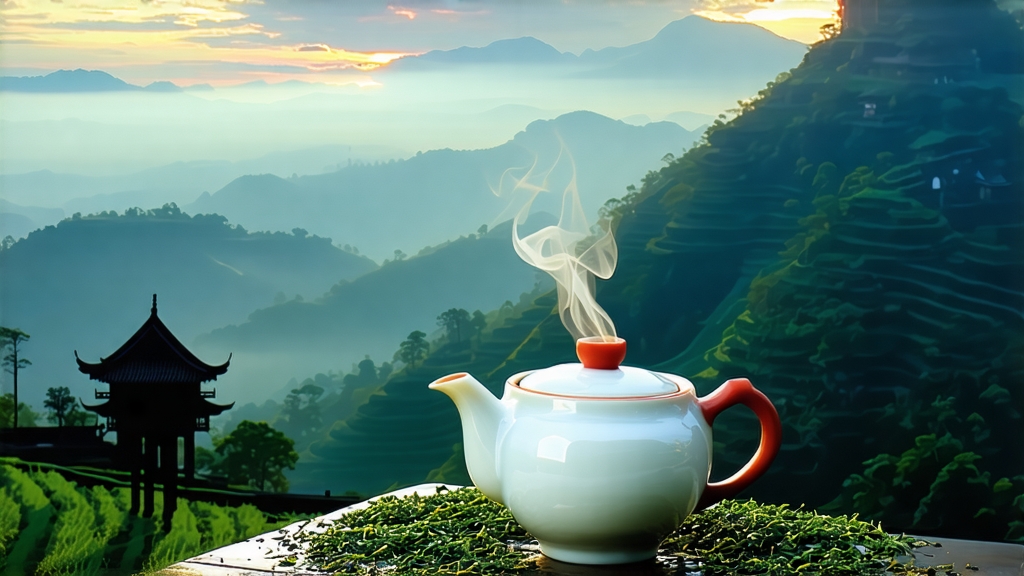
Ask most tea lovers to name the oldest black tea on earth and they will pause; mention Lapsang Souchong and the same faces light up with recognition. Hailing from the granite gorges of Tongmu Guan high inside China’s Wuyi Mountains, this extraordinary leaf is not merely a beverage—it is the progenitor of every modern black tea, the first to be fully oxidised and the first to travel beyond China’s borders, changing the palates of Europe and, eventually, the world.
Historical records kept by the local Xingcun guild show that by 1568 farmers in the Wuyi range had already abandoned the traditional green-tea pan-firing routine. A passing army had commandeered their workshops; when the soldiers left, the leaves had turned irrevocably red. In haste to dry the crop before mould set in, the farmers spread it over pinewood embers. The resulting liquor was copper-red, malty-sweet and carried an unmistakable whisper of campfire. Carried down the Min River to Xiamen’s international port, the tea was christened “Lapsang Souchong” by Dutch traders: “Lapsang” from the Fuzhou dialect lapu-sang meaning “pine wood”, and “Souchong” referring to the fourth or fifth leaf—larger, tougher, and ideal for withstanding smoke.
Today the European Union recognises Tongmu Guan as a protected origin; only leaf grown within the 565 km² core of the Wuyi reserve may legally bear the name Zheng Shan Xiao Zhong (“Original Mountain Small Sort”). Yet the family tree has branched. Connoisseurs speak of three main styles. The most classical, “Smoke-dried,” is withered over local Masson pine fires, oxidised in bamboo baskets rolled by foot, then finished above a pinewood hearth until the leaf absorbs a deep, resinous perfume. A newer “Unsmoked” or “Wuyi Gongfu” version follows the same oxidation curve but is dried with electric warm air, yielding a honeyed cup closer to dried longan. Between these poles sits “Light Smoke,” a compromise in which only the final drying stage meets pine, giving a subtle, lingering note that appears minutes after swallowing.
Craft begins before dawn. Pickers climb to 1,200 m where mist clings to the narrow leaf, keeping its cells turgid until the first wicker basket is filled. Back at the cottage, the leaves are spread on slatted bamboo trays suspended over a shallow pit of cool pinewood embers. The smoke is never allowed to burn hot; instead it drifts like incense for six to eight hours while the leaf loses roughly 60 % of its moisture. Once supple, the leaf is rolled—traditionally underfoot in a rattan creel—breaking cell walls and initiating oxidation. The twisted strips are then heaped in clay jars and covered with wet cloths; temperature and humidity rise, turning the leaf a uniform mahogany within three hours. Finally comes the firing: baskets are placed on a rack two hand-spans above a pine-resin fire so intense that droplets of sap hiss upward, kissing the leaf and sealing in the trademark aroma.
To brew Lapsang Souchong Western-style, weigh 3 g of leaf for every 250 ml of water. Use freshly drawn soft water just off the boil (95 °C). Infuse for four minutes; the liquor should glint like antique copper. If you prefer the Chinese gongfu ritual, load a 120 ml porcelain gaiwan with 5 g, flash-rinse to awaken the leaf, then steep successive infusions of 10, 15, 20 and 30 seconds. Watch the soup graduate from bright scarlet to deeper garnet; the smoke softens while cocoa and dried lychee notes emerge.
Tasting begins with the dry leaf. Bring a warmed cup to your nose: good Tongmu leaf smells first of pine tar, then of dark chocolate and finally of dried meadow-sweet—never of kerosene or burnt rubber, signs of cheaper external smoke. Slurp the liquor so it aerates across the palate; the initial campfire sensation should vanish within two seconds, replaced by a malty sweetness that lingers at the back of the throat. Swallow, then breathe out gently through the nose; a top-grade Lapsang will release a cooling camphor note reminiscent of Wuyi fir forests after rain. Finally, inspect the spent